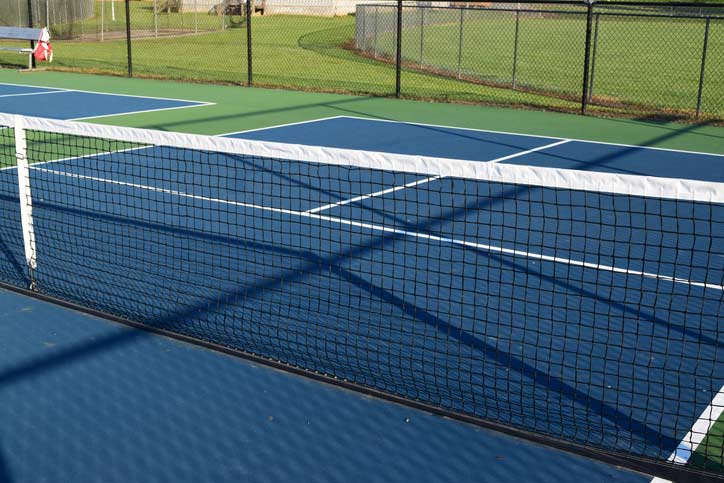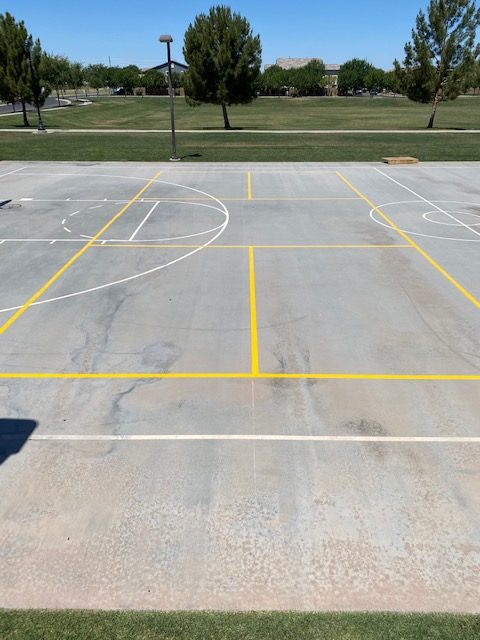A Comprehensive Guide to Designing the Perfect Pickleball Court for All Ability Degrees
Creating a pickleball court that deals with players of differing ability degrees necessitates a complex method, incorporating essential aspects such as court dimensions, surface materials, and accessibility attributes. The balance between functionality and safety is paramount, as is the production of a welcoming setting for both viewers and individuals. With the ideal style options, one can promote an engaging atmosphere that advertises pleasure and ability growth. Pickleball court contractor. The complexities involved in attaining this equilibrium are frequently forgotten. What particular considerations must be focused on to ensure an effective execution?

Understanding Court Dimensions
Comprehending the measurements of a pickleball court is crucial for both players and designers, as these specs guarantee a reasonable and regular playing experience. A common pickleball court determines 20 feet large by 44 feet long for both singles and doubles play. The court is divided right into 2 equivalent halves by an internet that stands 36 inches high at the sidelines and 34 inches at the center.
Key attributes of the court consist of the non-volley area, frequently referred to as the "kitchen," which extends 7 feet from the web on both sides. This area is essential for regulating gamer motion and volleying, guaranteeing strategic play. Furthermore, the service locations on each side of the court are important, measuring 10 feet vast and 15 feet deep, created to accommodate proper offering strategies.
Surrounding the court, a location of at least 10 feet need to be assigned as the safety and security zone, enabling players sufficient space to relocate and protect against injuries during play. Sticking to these measurements not only promotes fair competitors but additionally promotes security and pleasure for all individuals, making it crucial for any type of pickleball court style.
Selecting the Right Surface Area
The selection of playing surface area for a pickleball court substantially affects the video game's characteristics and gamer experience. Selecting the appropriate material is vital for ensuring gamer convenience, security, and efficiency. Usual surface areas include asphalt, concrete, and specialized sporting activities floor covering.
Asphalt is a popular choice as a result of its cost and toughness. It offers a regular playing surface area however can be hard on joints over extended play. Concrete, while similar in durability, uses very little adaptability, possibly leading to raised effect on gamers' bodies.
For an extra supported experience, numerous centers choose customized sporting activities flooring, such as modular floor tiles or synthetic surface areas. These materials usually include shock-absorbing homes, lowering the threat of injuries and boosting gamer comfort. In addition, such surfaces can improve ball bounce consistency, which is vital for reasonable play.
When choosing a surface, think about elements such as climate, maintenance demands, and the intensity of play. A well-chosen surface not only enhances gameplay but also contributes to the long life of the court itself. Inevitably, recognizing the nuances of different products will certainly help in producing an ideal pickleball environment customized to different skill levels.
Ideal Court Layout
An optimal court design is vital for making the most of both player efficiency and spectator pleasure in pickleball. The measurements of a typical pickleball court are 20 feet large by 44 feet long for doubles play, keeping a clear border that improves gameplay. The web, placed at 36 inches high at the sidelines and 34 inches browse this site in the center, is vital for maintaining the dynamics of the video game.
Incorporating assigned locations around the court for players to move easily is vital. A minimum of 10 feet of clearance on all sides of the court is advised to stop crashes and provide area for viewers. Additionally, alignment plays a significant role; the court must preferably be aligned north-south to reduce the effect of sunlight glow on players during peak hours.
Efficient viewer placement is equally essential. Elevated seeing bleachers or locations placed behind the sidelines can boost the experience while ensuring safety and security. Lastly, visible and clear court markings aid in gameplay, with contrasting shades for borders and non-volley areas that delineate crucial areas for players. In general, a well-designed court format fosters an engaging environment for both players and viewers.

Availability Considerations
When developing a pickleball court, ensuring access for all players, consisting of those with specials needs, is critical. An attentively created court can foster inclusivity and urge involvement from people of varying capacities.

Gain access to paths to the court must likewise be very carefully intended. Make certain that paths leading to the court are broad enough for wheelchair individuals and are furnished with ramps where needed. see this site Signage must be big and clear enough to be easily read.
Moreover, seating locations need to be designed to permit easy accessibility to and from the court. This consists of supplying assigned rooms for spectators who might have flexibility obstacles.
Finally, ensure that toilet facilities neighboring satisfy accessibility requirements. By considering these components, you can create a pickleball court that is inviting and usable for everybody, therefore promoting a varied and lively area of gamers.
Upkeep and Upkeep
Appropriate upkeep and upkeep of a pickleball court are necessary for guaranteeing ideal having fun problems and prolonging the lifespan of the facility. Routine evaluations need to be performed to identify and deal with any kind of problems or put on, such as splits in the surface or loosened netting. These concerns, if left neglected, can adversely influence gameplay and safety.
Surface area upkeep is crucial; courts should be cleaned frequently to remove debris, leaves, or dust that can influence grip. For tough courts, regular stress washing is recommended to maintain surface area honesty and aesthetics. If your court is made Related Site of softer materials, such as asphalt, securing or resurfacing may be necessary to shield versus weather-related wear.
Furthermore, internet elevation and tension should be checked regularly, as inappropriate settings can alter gameplay. Keeping surrounding locations, consisting of fence and lighting, is just as crucial for making sure a risk-free and pleasurable atmosphere.
Final Thought
In conclusion, the style of a perfect pickleball court requires a careful technique that includes appropriate dimensions, appropriate surface materials, and thoughtful layout. By adhering to these standards, the best pickleball court can be produced, advertising satisfaction and sports advancement for players of differing ability degrees.
Designing a pickleball court that provides to gamers of differing ability levels necessitates a multifaceted technique, including essential components such as court measurements, surface area materials, and accessibility attributes.Understanding the measurements of a pickleball court is vital for both developers and players, as these specs ensure a fair and regular having fun experience.The selection of playing surface for a pickleball court significantly affects the game's characteristics and player experience.An optimal court design is important for maximizing both gamer performance and spectator enjoyment in pickleball. By adhering to these standards, the ideal pickleball court can be produced, advertising satisfaction and sports development for players of varying skill levels.